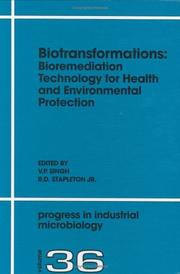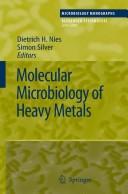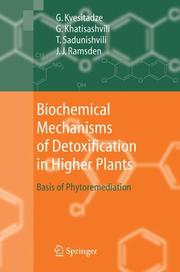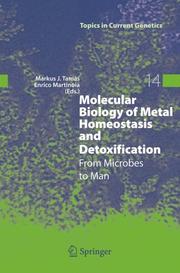| Listing 1 - 9 of 9 |
Sort by
|

ISBN: 9780444509970 0444509976 9780080528205 0080528201 1281186767 9781281186768 9786611186760 661118676X Year: 2002 Publisher: Amsterdam ; New York : Elsevier Science Ltd.,
Abstract | Keywords | Export | Availability | Bookmark
 Loading...
Loading...Choose an application
- Reference Manager
- EndNote
- RefWorks (Direct export to RefWorks)
This volume provides a clear understanding of how microbes, following their degradative processes, contribute maximally to the benefit of mankind through biotransformations of waste materials as well as a wide variety of health-risk compounds. The book contains twenty four chapters contributed by leading scientists from different parts of the world, covering various aspects of bioremediation of xenobiotics such as toxic, carcinogenic, teratogenic, and mutagenic compounds, which include halogenated aromatics, derivatives of heavy metals, microbial toxins, tannins, dyes, sulfur compounds o
Biodegradation. --- Biotransformation (Metabolism) --- Metabolic detoxification. --- Bioremediation.
Book
ISBN: 0444819770 9786611058180 1281058181 0080544924 9780444819772 9780080544922 Year: 1995 Publisher: Amsterdam ; New York : Elsevier,
Abstract | Keywords | Export | Availability | Bookmark
 Loading...
Loading...Choose an application
- Reference Manager
- EndNote
- RefWorks (Direct export to RefWorks)
A comprehensive and consolidated account of how microorganisms can play a significant role in degrading and detoxifying toxic, carcinogenic, mutagenic, and teratogenic compounds is detailed in this book. Moreover, the volume deals with all aspects of microbial degradation, ranging from screening methods for the degradative microorganisms, processes of degradation, strain improvement for enhanced biodegradation, and elimination of undesirable compounds to improving health and environmental protection strategies. The book will provide an opportunity for scientists in the areas of microbiology,
Microbial metabolism --- Biotransformation (Metabolism) --- Xenobiotics --- Metabolic detoxication --- Biodegradation --- Xenobiotics - Biodegradation. --- Microbial metabolism. --- Foreign chemical compounds --- Foreign compounds --- Xenobiotic compounds --- Biochemistry --- Chemicals --- Activation, Metabolic --- Bioactivation (Metabolism) --- Biodegradation (Metabolism) --- Metabolic activation --- Metabolism --- Pharmacology --- Bacterial metabolism --- Metabolism, Bacterial --- Microorganisms --- Biodegradation. --- Metabolic detoxification. --- Physiology

ISSN: 18625576 ISBN: 1280817739 9786610817733 3540697713 3540697705 364208916X Year: 2007 Volume: 6 Publisher: Berlin ; New York : Springer,
Abstract | Keywords | Export | Availability | Bookmark
 Loading...
Loading...Choose an application
- Reference Manager
- EndNote
- RefWorks (Direct export to RefWorks)
All forms of life depend on a variety of heavy metal ions. Nearly one-third of all gene products require a metal ion for proper folding or function. However, even metals generally regarded as non-poisonous are toxic at higher concentrations, including the essential ones. Thus, sensitive regulation of metal uptake, storage, allocation and detoxification is needed to maintain cellular homeostasis of heavy metal ions. Molecular Microbiology of Heavy Metals includes chapters on allocation of metals in cells, metal transporter, storage and metalloregulatory proteins, cellular responses to metal ion stress, transcription of genes involved in metal ion homeostasis, uptake of essential metals, metal efflux and other detoxification mechanisms. Also discussed are metal bioreporters for the nanomolar range of concentration and tools to address the metallome. Chapters in the second part cover specific metals such as Fe, Mn, Cu, Ni, Co, Zn and Mo as key nutrient elements and Ag, As, Cd, Hg and Cr as toxic elements.
Bacteria -- Metabolism. --- Bacterial proteins -- Metabolism. --- Cation transport proteins -- Metabolism. --- Heavy metals -- Metabolism. --- Metabolic detoxication, Drug. --- Metal ions -- Metabolic detoxification. --- Metal ions -- Metabolism. --- Metals, Heavy -- Metabolism. --- Molecular genetics. --- Metal ions --- Heavy metals --- Molecular genetics --- Ion Pumps --- Proteins --- Organisms --- Biotransformation --- Metabolic Phenomena --- Elements --- Metals --- Amino Acids, Peptides, and Proteins --- Inorganic Chemicals --- Phenomena and Processes --- Membrane Transport Proteins --- Chemicals and Drugs --- Membrane Proteins --- Carrier Proteins --- Metabolic Detoxication, Drug --- Metabolism --- Bacteria --- Cation Transport Proteins --- Metals, Heavy --- Bacterial Proteins --- Human Anatomy & Physiology --- Biology --- Health & Biological Sciences --- Animal Biochemistry --- Microbiology & Immunology --- Metabolic detoxification --- Metabolism. --- Metabolic detoxification. --- Life sciences. --- Organometallic chemistry. --- Biochemistry. --- Microbiology. --- Bacteriology. --- Microbial genetics. --- Microbial genomics. --- Life Sciences. --- Biochemistry, general. --- Microbial Genetics and Genomics. --- Organometallic Chemistry. --- Genomics --- Microbial genetics --- Microorganisms --- Genetics --- Microbiology --- Microbial biology --- Biological chemistry --- Chemical composition of organisms --- Physiological chemistry --- Chemistry --- Medical sciences --- Chemistry, Organometallic --- Metallo-organic chemistry --- Chemistry, Organic --- Biosciences --- Sciences, Life --- Science --- Composition --- Molecular biology --- Ions --- Toxic metals --- Poisons --- Chemistry, Organic. --- Organic chemistry --- Organometallic chemistry .
Book
ISBN: 364221407X 9786613469984 1283469987 3642214088 Year: 2011 Publisher: Heidelberg : Springer,
Abstract | Keywords | Export | Availability | Bookmark
 Loading...
Loading...Choose an application
- Reference Manager
- EndNote
- RefWorks (Direct export to RefWorks)
Heavy metals are severe environmental pollutants, and many of them are toxic even at very low concentrations. With industrial development, soil pollution with heavy metal elements have dramatically increased. The uptake of heavy metals via plants that are exposed to contaminated soils is a risk for human health and a major hazard for the ecosystem as a whole, including soil microorganisms. On the other hand, plants may be used in the decontamination of soils. The topics presented in this book include: sources of heavy metals contaminants in soils; plant species that can grow on contaminated soils; the phytoremediation of contaminated soils; tolerance, accumulation and detoxification mechanisms of zinc, copper, arsenic, cadmium and vanadium in plants; the critical role of sulfur metabolism in heavy metal tolerance; the role of aquatic macrophytes, plant growth-promoting bacteria, sugar crops and earthworms in detoxification; and heavy metal stabilization by promoting zeolite synthesis in soils.
Soils --- Heavy metals --- Phytoremediation --- Botany --- Civil & Environmental Engineering --- Earth & Environmental Sciences --- Engineering & Applied Sciences --- Plant Physiology --- Environmental Engineering --- Heavy metal content --- Toxicology --- Metabolic detoxification. --- Toxicology. --- Chemicals --- Detoxication, Metabolic --- Detoxification, Metabolic --- Metabolic detoxication --- Metabolic detoxification --- Life sciences. --- Plant biochemistry. --- Plant physiology. --- Soil science. --- Soil conservation. --- Life Sciences. --- Plant Physiology. --- Plant Biochemistry. --- Soil Science & Conservation. --- Biotransformation (Metabolism) --- Metabolic conjugation --- Biochemistry. --- Conservation of soil --- Erosion control, Soil --- Soil erosion --- Soil erosion control --- Agricultural conservation --- Soil management --- Biological chemistry --- Chemical composition of organisms --- Organisms --- Physiological chemistry --- Biology --- Chemistry --- Medical sciences --- Plants --- Physiology --- Control --- Prevention --- Conservation --- Composition --- Pedology (Soil science) --- Agriculture --- Earth sciences --- Phytochemistry --- Plant biochemistry --- Plant chemistry --- Biochemistry --- Phytochemicals --- Plant biochemical genetics

ISBN: 1280610506 9786610610501 3540289976 3540289968 3642067026 Year: 2006 Publisher: Berlin ; New York : Springer,
Abstract | Keywords | Export | Availability | Bookmark
 Loading...
Loading...Choose an application
- Reference Manager
- EndNote
- RefWorks (Direct export to RefWorks)
Plants play a key role in purifying the biosphere of the toxic effects of industrial activity. This book shows how systematic application of the results of investigations into the metabolism of xenobiotics (foreign, often toxic substances) in plants could make a vastly increased contribution to planetary well-being. Deep physiological knowledge gained from an accumulation of experimental data enables the great differences between the detoxifying abilities of different plants for compounds of different chemical nature to be optimally exploited. Hence planting could be far more systematically adapted to actual environmental needs than is actually the case at present. The book could form the basis of specialist courses in universities and polytechnics devoted to environmental management, and advanced courses in plant physiology and biochemistry, for botany and integrative biology students. Fundamental plant physiology and biochemistry from the molecular level to whole plants and ecosystems are interwoven in a powerful and natural way, making this a unique contribution to the field.
Phytoremediation. --- Plants --- Metabolic detoxification. --- Metabolism. --- Effect of pollution on. --- Plants, Effect of pollution on --- Pollution --- Plant metabolism --- Metabolism --- Plant physiology --- Vegetation-based remediation --- Vegetative bioremediation --- Bioremediation --- Chemicals --- Detoxication, Metabolic --- Detoxification, Metabolic --- Metabolic detoxication --- Biotransformation (Metabolism) --- Metabolic conjugation --- Physiological effect --- Effect of anaerobiosis on --- Metabolic detoxification --- Biotechnology. --- Food science. --- Biochemistry. --- Plant Ecology. --- Environmental protection. --- Environmental management. --- Food Science. --- Plant Biochemistry. --- Atmospheric Protection/Air Quality Control/Air Pollution. --- Environmental Management. --- Environmental stewardship --- Stewardship, Environmental --- Environmental sciences --- Management --- Botany --- Ecology --- Biological chemistry --- Chemical composition of organisms --- Organisms --- Physiological chemistry --- Biology --- Chemistry --- Medical sciences --- Science --- Environmental quality management --- Protection of environment --- Applied ecology --- Environmental engineering --- Environmental policy --- Environmental quality --- Chemical engineering --- Genetic engineering --- Composition --- Phytoecology --- Vegetation ecology --- Food—Biotechnology. --- Plant biochemistry. --- Plant ecology. --- Air pollution. --- Air --- Air contaminants --- Air pollutants --- Air pollution --- Air pollution control --- Air toxics --- Airborne pollutants --- Atmosphere --- Contaminants, Air --- Control of air pollution --- Pollutants, Air --- Toxics, Air --- Air quality --- Atmospheric deposition --- Phytochemistry --- Plant biochemistry --- Plant chemistry --- Biochemistry --- Phytochemicals --- Plant biochemical genetics --- Control --- Floristic ecology

ISSN: 16102096 ISBN: 9783540221753 3540221751 3540317198 Year: 2006 Volume: 14 Publisher: Berlin, Heidelberg : Springer Berlin Heidelberg : Imprint: Springer,
Abstract | Keywords | Export | Availability | Bookmark
 Loading...
Loading...Choose an application
- Reference Manager
- EndNote
- RefWorks (Direct export to RefWorks)
One of the challenges faced by every cell as well as by whole organisms is to maintain appropriate concentrations of essential nutrient metals while excluding nonessential toxic metals. Toward that end, all organisms have developed mechanisms for metal homeostasis and detoxification to maintain metal levels within physiological limits. This book brings together current knowledge of the molecular basis of metal homeostasis and detoxification in various eukaryotic model systems, including yeasts, plants, and mammals. It focuses on the cellular systems controlling metal transport, intracellular distribution, and immobilization as well as on systems regulating metal-dependent transcription. In addition to environmental aspects (including phytoremediation), the book treats the pathophysiology of metal deficiency and overload in relation to disease.
Metalloproteins --- Metals --- Homeostasis --- Molecular Biology --- Metal ions --- Molecular genetics --- Métalloprotéines --- Génétique moléculaire --- Homéostasie --- metabolism --- Metabolism --- Metabolic detoxification --- Physiological Processes --- Proteins --- Biochemistry --- Inorganic Chemicals --- Genetics --- Biological Science Disciplines --- Chemistry --- Biology --- Amino Acids, Peptides, and Proteins --- Chemicals and Drugs --- Physiological Phenomena --- Natural Science Disciplines --- Phenomena and Processes --- Disciplines and Occupations --- Biology - General --- Animal Biochemistry --- Human Anatomy & Physiology --- Health & Biological Sciences --- Physical Sciences & Mathematics --- Disorders --- Metal --- Metabolic detoxification. --- Disorders. --- Metabolism. --- Metallic elements --- Life sciences. --- Biochemistry. --- Cell biology. --- Microbiology. --- Plant physiology. --- Life Sciences. --- Biochemistry, general. --- Cell Biology. --- Biomedicine general. --- Plant Physiology. --- Chemical elements --- Ores --- Metallurgy --- Cytology. --- Medicine. --- Botany --- Plants --- Physiology --- Clinical sciences --- Medical profession --- Human biology --- Life sciences --- Medical sciences --- Pathology --- Physicians --- Microbial biology --- Microorganisms --- Cell biology --- Cellular biology --- Cells --- Cytologists --- Biological chemistry --- Chemical composition of organisms --- Organisms --- Physiological chemistry --- Composition --- Health Workforce --- Biomedicine, general. --- Medicine --- Biomedical Research. --- Research. --- Biological research --- Biomedical research
Periodical
ISSN: 16789180 Year: 2003 Publisher: Botucatu, SP, Brazil : CEVAP,
Abstract | Keywords | Export | Availability | Bookmark
 Loading...
Loading...Choose an application
- Reference Manager
- EndNote
- RefWorks (Direct export to RefWorks)
Poisonous animals --- Venom --- Tropical medicine --- Venoms. --- Toxins. --- Animals, Poisonous. --- Tropical Medicine. --- Poisonous animals. --- Tropical medicine. --- Venom. --- Toxins, Biological. --- Biology. --- Venoms --- Diseases, Tropical --- Hygiene, Tropical --- Public health, Tropical --- Sanitation, Tropical --- Tropical diseases --- Medicine, Tropical --- Poisonous Animals --- Animal, Poisonous --- Poisonous Animal --- Biological Toxins --- Antivenins --- Toxins --- Medical climatology --- Medicine --- Dangerous animals --- Toxoids --- venoms. --- toxins. --- biotoxins --- toxic substances --- cytotoxins --- food toxins --- hepatotoxins --- marine toxins --- microbial toxins --- nematotoxins --- nephrotoxins --- neurotoxins --- phototoxins --- phytotoxins --- antitoxins --- detoxification (processing) --- metabolic detoxification --- toxicity --- toxicology --- toxigenesis --- bodily secretions and exudates --- amphibian venoms --- arthropod venoms --- conotoxins --- snake venoms --- antivenoms --- bites and stings --- Toxins, Biological --- Animals, Poisonous --- Tropical Medicine
Periodical
ISSN: 18732763 Year: 1985 Publisher: Elmsford, NY : Pergamon,
Abstract | Keywords | Export | Availability | Bookmark
 Loading...
Loading...Choose an application
- Reference Manager
- EndNote
- RefWorks (Direct export to RefWorks)
Bones --- Bone --- Metabolism --- Os --- Bone Diseases, Metabolic. --- Osteology --- Metabolic Bone Diseases --- Osteopenia --- Bone Disease, Metabolic --- Disease, Metabolic Bone --- Diseases, Metabolic Bone --- Metabolic Bone Disease --- Osteopenias --- Physiology --- Pathophysiology --- Diseases --- Physiologie --- Périodiques. --- Physiopathologie --- Maladies --- Diseases. --- Pathophysiology. --- Physiology. --- Musculoskeletal system --- Skeleton --- Bone Diseases, Metabolic --- Low Bone Density --- Low Bone Mineral Density --- Bone Density, Low --- Low Bone Densities --- anabolism --- catabolism --- biochemistry --- physiology --- biocatalysis --- biosynthesis --- carbohydrate metabolism --- carbon metabolism --- catabolite repression --- copper metabolism --- dealkylation --- energy metabolism --- hormone metabolism --- lipid metabolism --- metabolic detoxification --- metabolic sequestration --- mineral metabolism --- nitrogen metabolism --- pharmacokinetics --- protein metabolism --- steroid metabolism --- vitamin metabolism --- water metabolism --- metabolic flux analysis --- metabolic studies --- metabolites --- metabolome --- metabolomics --- oxidative stress --- connective tissues --- musculoskeletal system --- bone density --- bone marrow --- bone types --- clavicle --- epiphyses --- sternum --- bone health --- renal osteodystrophy --- bone transplantation --- Bone Diseases, Metabolic, --- bones --- metabolism
Periodical
Abstract | Keywords | Export | Availability | Bookmark
 Loading...
Loading...Choose an application
- Reference Manager
- EndNote
- RefWorks (Direct export to RefWorks)
Cell metabolism --- Cells --- Metabolic Diseases --- Homeostasis --- metabolism --- Metabolic Diseases. --- Homeostasis. --- Cellules --- Cell metabolism. --- Métabolisme cellulaire. --- metabolism. --- Métabolisme --- Autoregulation --- Diseases, Metabolic --- Thesaurismosis --- Disease, Metabolic --- Metabolic Disease --- Thesaurismoses --- Metabolism --- Cell --- Cell Biology --- Cellular control mechanisms --- Métabolisme cellulaire. --- Métabolisme --- Cytology --- cells. --- metabolic diseases. --- homeostasis. --- biochemistry --- physiology --- anabolism --- biocatalysis --- biosynthesis --- carbohydrate metabolism --- carbon metabolism --- catabolism --- catabolite repression --- copper metabolism --- dealkylation --- energy metabolism --- hormone metabolism --- lipid metabolism --- metabolic detoxification --- metabolic sequestration --- mineral metabolism --- nitrogen metabolism --- pharmacokinetics --- protein metabolism --- steroid metabolism --- vitamin metabolism --- water metabolism --- metabolic flux analysis --- metabolic studies --- metabolites --- metabolome --- metabolomics --- oxidative stress --- cell biology --- acinar cells --- adipocytes --- aleurone cells --- antigen-presenting cells --- bacteriocytes --- blood cells --- bone marrow cells --- bundle sheath cells --- chondrocytes --- chromaffin cells --- chromatophores --- coelomocytes --- cultured cells --- endothelial cells --- epithelial cells --- eukaryotic cells --- fibroblasts --- germ cells --- giant cells --- gonadotropic cells --- granulosa cells --- guard cells --- hemocytes --- hepatocytes --- islets of Langerhans --- keratinocytes --- kidney cells --- Leydig cells --- luteal cells --- mast cells --- myocytes --- neoplasm cells --- neurosecretory cells --- nurse cells --- osteoblasts --- osteoclasts --- phagocytes --- plant root cells --- prokaryotic cells --- Schwann cells --- Sertoli cells --- somatic cells --- splenocytes --- spores --- stem cells --- stromal cells --- tenocytes --- teratocytes --- thecal cells --- vegetative cells --- artificial cells --- cell transplantation --- cell viability --- cellular microenvironment --- physiological regulation --- autoregulation --- glucagon-like peptide 2 --- glucoregulation --- glucose tolerance tests --- metabolic disorders --- noninfectious diseases --- acidosis --- alkalosis --- calcinosis --- carbohydrate metabolism disorders --- dehydration (animal physiology) --- developmental orthopedic disease --- diabetes --- hypercalcemia --- hyperinsulinemia --- hyperkalemia --- hyperketonemia --- hypocalcemia --- hypokalemia --- hypomagnesemia --- hyponatremia --- inherited metabolic diseases --- iron overload --- ketonemia --- ketonuria --- lipid metabolism disorders --- osteomalacia --- refeeding syndrome --- uremia --- malnutrition --- Metabolisme cel·lular --- Citologia --- Homeòstasi
| Listing 1 - 9 of 9 |
Sort by
|

 Search
Search Feedback
Feedback About UniCat
About UniCat  Help
Help News
News